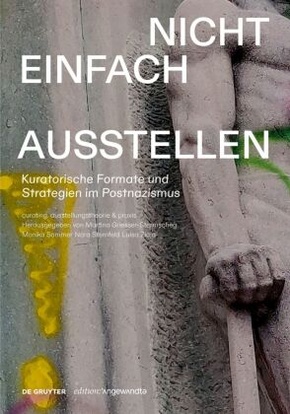Nicht einfach ausstellen - Kuratorische Formate und Strategien im Postnazismus
| Verlag | De Gruyter |
| Auflage | 2024 |
| Seiten | 272 |
| Format | 14,5 x 2,0 x 21,0 cm |
| Großformatiges Paperback. Klappenbroschur | |
| Gewicht | 588 g |
| Reihe | Edition Angewandte |
| ISBN-10 | 3111364496 |
| ISBN-13 | 9783111364490 |
| Bestell-Nr | 11136449A |
NS-Kontinuitäten konfrontieren
Wie mit Kontinuitäten des Nazismus im 21. Jahrhundert kuratorisch umgehen? Der Sammelband widmet sich kuratorischen Formaten und Strategien, die Mechanismen des Verdrängens und Verleugnens der Nazigeschichte adressieren und bearbeiten.
Die Beiträge analysieren die Normalisierung faschistischer Ästhetiken und Diskurse. Sie positionieren sich innerhalb neuer Debatten um Erinnerungspolitiken, suchen Möglichkeiten, sich Gewaltgeschichten zu stellen, und reflektieren Kontexte und Projekte in Museen, Hochschulen und im öffentlichen Raum.
Welche Rolle spielt Erinnerung in kuratorischen Projekten zwischen Auseinandersetzung und Entledigung? Beschäftigen wir uns mit dem Thema, um uns nicht damit beschäftigen zu müssen? Oder wollen wir es nicht vielmehr zeigen, um uns mit den Kontinuitäten in der Gegenwart zu konfrontieren?
Blick ins Buch
Praktiken des Umgangs mit NS-Kontinuitäten in Bezug auf Denkmäler, Sammlungsbestände, institutionelle Strukturen 7. Band der Unterreihe /ecm (educating/curating/making), mit Texten internationaler Expert:innen aus Theorie und Praxis sowie künstlerischen Arbeiten Beiträge von Sophie Goltz, Angela Koch, Michaela Melián, Ruth Sonderegger, Julia Voss u. a.
Confronting Nazi continuities
How can museums and institutions deal with the continuities of Nazism in the 21st century? This anthology is dedicated to curatorial formats and strategies that address mechanisms of repression and denial of Nazi history.
The contributions analyze the normalization of fascist aesthetics and discourses. They position themselves within new debates about the politics of memory, seek ways to confront histories of violence, and reflect on contexts and projects in museums, universities, and public spaces.
What role does memory play in curatorial projects that confront the tendency to ignore or dismiss Austria's Nazi past? Do we deal with the topic in order not to have to deal with it? Or do we confront it in order to confront the continuities in the present?
Look inside
Practices of dealing with Nazi continuities in relation to monuments, art collections, and institutional structures 7th volume of the /ecm (educating/curating/making) sub-series, with texts by international experts from theory and practice and works of art Contributions by Sophie Goltz, Angela Koch, Michaela Melián, Ruth Sonderegger, Julia Voss, and more

